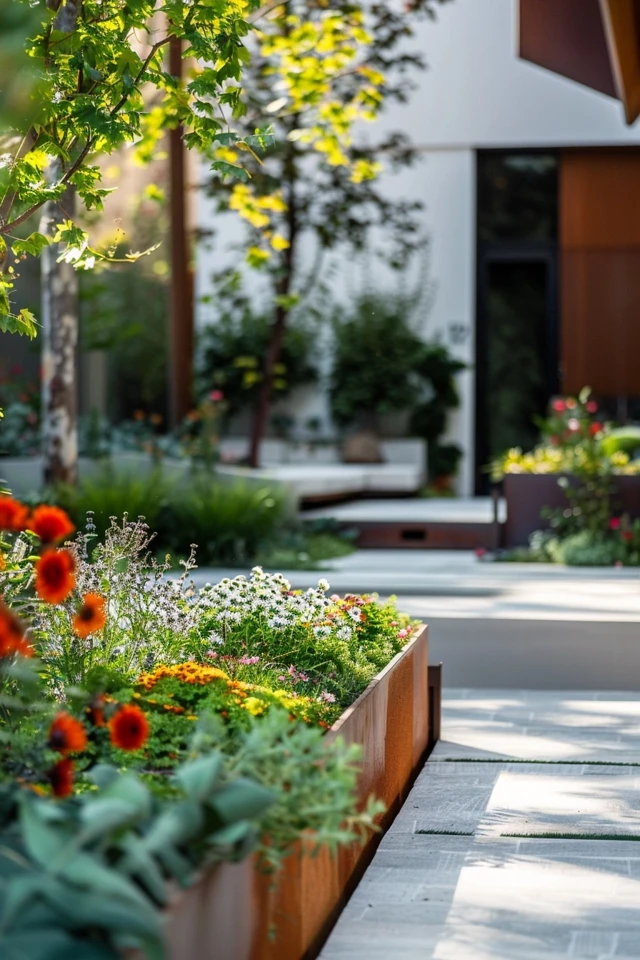Hey there! Are you tired of spending countless hours maintaining your yard? I know I was. That’s when I discovered the wonders of sustainable landscaping and zero scape ideas. Let me share a little story to set the stage for our main topic.
A few years ago, I found myself overwhelmed with the constant watering, mowing, and pruning required to keep my yard looking presentable. Not to mention the hefty water bills and the guilt of wasting this precious resource.
One day, while browsing through a gardening magazine, I stumbled upon an article about drought-tolerant landscaping and xeriscaping. Intrigued by the idea of creating a low-maintenance garden that also saves water, I delved into the world of sustainable landscape design.
I started by transforming my yard into a modern oasis filled with beautiful, drought-tolerant plants and eco-friendly outdoor spaces. I no longer had to worry about excessive watering or spending my weekends pulling weeds.
Now, my once dull and labor-intensive yard has become an inviting space that requires minimal effort to maintain. And the best part? I’m doing my part to conserve water and protect the environment.
Key Takeaways:
- Zero scape ideas offer a practical and eco-friendly approach to landscaping.
- Drought-tolerant plants and xeriscaping techniques can create a low-maintenance and water-wise garden.
- Sustainable landscape design promotes the use of native plants and hardscape elements for a visually appealing outdoor space.
- Maximizing water conservation and energy efficiency are crucial components of a sustainable yard.
- By embracing zero scape ideas, you can enjoy a beautiful and sustainable landscape while reducing your environmental impact.

Incorporating Drought-Tolerant Plants and Hardscapes
One key component of zero scape ideas is incorporating drought-tolerant plants and hardscapes. By selecting plants that are adapted to your local climate and require minimal water, you can reduce your water usage while still enjoying a beautiful and vibrant yard.
Drought-tolerant plants are specifically designed to survive in arid conditions and can thrive without the need for excessive watering. Some popular options include succulents, such as agave and aloe vera, as well as ornamental grasses like feather reed grass and blue fescue. These plants not only add texture and color to your landscape, but they also have unique water storage capabilities that allow them to withstand prolonged periods of dry weather.
Furthermore, incorporating hardscape elements such as gravel and mulch can help conserve water and add visual interest to your landscape. Gravel is an excellent ground cover option that allows rainwater to percolate into the soil, preventing runoff and promoting groundwater recharge. It also helps to minimize weed growth and erosion. Mulch, on the other hand, acts as a natural moisture barrier, reducing evaporation and maintaining soil moisture levels. It also suppresses weed growth and adds a cohesive look to your outdoor space.
When designing your zero scape, it’s also important to consider using native plants. Native plants are naturally adapted to the local ecosystem and have evolved to thrive in your specific area’s climate, soil, and rainfall patterns. As a result, they require minimal maintenance and are more resistant to pests and diseases. By incorporating native plants in your landscape, you can establish a self-sustaining ecosystem that supports local wildlife and helps conserve water.
By incorporating drought-tolerant plants and hardscapes in your landscape design, you can create a visually stunning yard while conserving water and reducing maintenance. Harness the beauty of nature’s adaptability and create an eco-friendly outdoor space that flourishes even in the face of water scarcity.

Maximizing Water Conservation and Energy Efficiency
Another important aspect of sustainable landscaping is maximizing water conservation and energy efficiency. By implementing these strategies, you can reduce your environmental impact while still enjoying a beautiful and functional outdoor space.
One way to conserve water is through rainwater harvesting. Installing a rainwater harvesting system allows you to collect and reuse rainwater for irrigation purposes. This not only reduces your reliance on municipal water sources but also helps prevent runoff and erosion. By utilizing rainwater, you can minimize water waste and contribute to a more sustainable landscape.
In addition to water conservation, incorporating energy-efficient elements into your landscape design is essential. Consider using solar-powered lighting to illuminate your outdoor space. Solar-powered lights are not only eco-friendly but also cost-effective in the long run. By harnessing energy from the sun, you can reduce your energy consumption and lower your carbon footprint.
To further enhance energy efficiency, explore options like smart irrigation systems that use weather data and soil moisture sensors to optimize watering schedules. These technologies ensure that your plants receive the right amount of water without wastage.
Integrating water conservation and energy efficiency into your zero scape design not only benefits the environment but also saves you money in the long run. It’s a win-win situation, creating a beautiful and sustainable outdoor space while minimizing your ecological impact.

Conclusion
Sustainable zero scape ideas offer a practical and environmentally friendly approach to landscaping. By incorporating drought-tolerant plants, hardscapes, and water conservation techniques, you can create a low-maintenance and visually appealing yard that helps conserve water and reduce your environmental impact.
Embracing native plants, which are well-adapted to your local climate, can significantly decrease water usage while adding a touch of natural beauty to your outdoor space. Pairing these plants with hardscape elements like gravel and mulch not only conserves water but also adds texture and interest to your landscape design.
Implementing water conservation strategies such as rainwater harvesting can further enhance the sustainability of your garden. By collecting and reusing rainwater for irrigation purposes, you not only save water but also reduce runoff and erosion.
Additionally, incorporating energy-efficient lighting solutions like solar-powered lights can help reduce your energy consumption and minimize your carbon footprint. By integrating these eco-friendly practices into your zero scape design, you can create an outdoor space that showcases both style and sustainability. So, start implementing these zero scape ideas today and enjoy a beautiful, sustainable landscape that stands the test of time.

